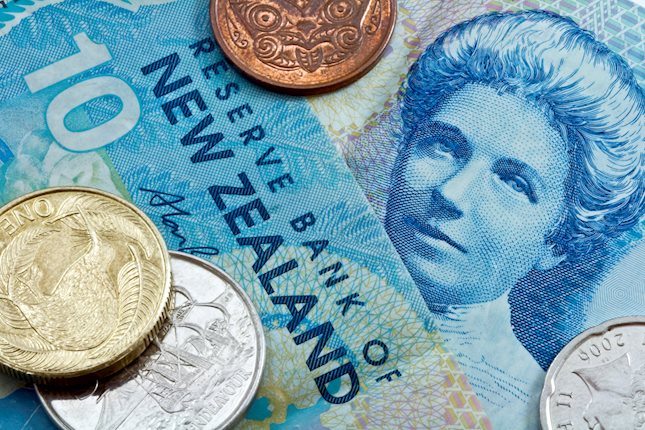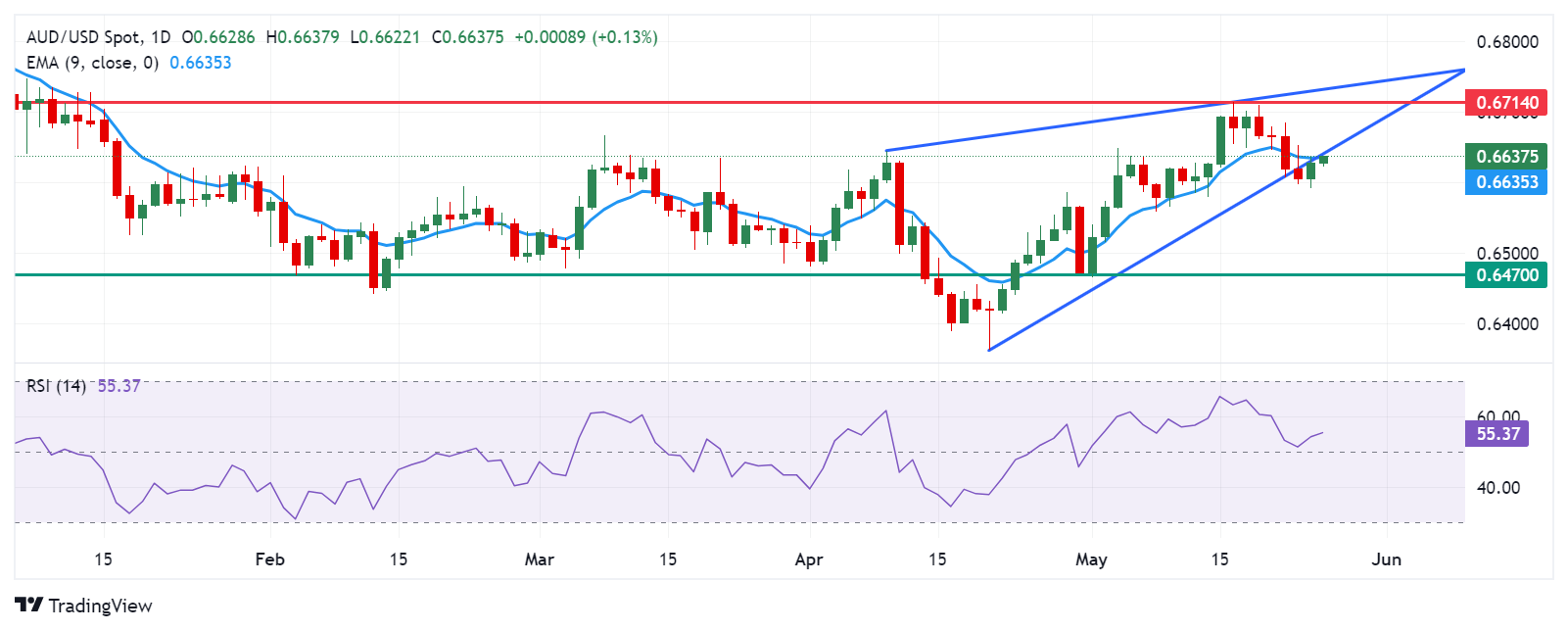- The Australian Dollar gained ground due to risk-on sentiment after softer UoM 5-year Inflation Expectation on Friday.
- Australian equities rose above 7,770, following gains on Wall Street from Friday.
- The US Dollar weakened after the UoM 5-year Consumer Inflation Expectations (May) eased to 3.0% compared to the estimated 3.1%.
The Australian Dollar (AUD) extends its gains against the US Dollar (USD) for the second consecutive session on Monday as overall market risk appetite improved, despite diminishing expectations for Federal Reserve interest rate cuts. Meanwhile, investors eagerly anticipate Australia's Retail Sales on Tuesday, which is expected to grow 0.3% in April, swinging from the previous decline of 0.4%.
The Australian Dollar may gain ground as the latest Reserve Bank of Australia (RBA) meeting minutes suggested that the board found it difficult to predict future changes in the cash rate, acknowledging that recent data increases the likelihood of inflation persisting above the 2-3% target for a prolonged duration.
The US Dollar (USD) weakened following the release of the University of Michigan's 5-year Consumer Inflation Expectations for May on Friday. It eased slightly to 3.0%, below the forecasted 3.1%. Despite the upward revision of the Consumer Sentiment Index to 69.1 from a preliminary reading of 67.4, it still marked the lowest level in six months. These figures likely contributed to strengthening investors’ sentiment regarding potential rate cuts by the Federal Reserve.
According to the CME FedWatch Tool, the probability of the Federal Reserve implementing a 25 basis-point rate cut in September has decreased to 44.9% from 49.0% a week earlier. It is worth noting that the US market will be closed due to the Memorial Day bank holiday on Monday.
Daily Digest Market Movers: Australian Dollar advances due to improved risk sentiment
- China launched a US$47 billion state-backed fund on May 24 to bolster its semiconductor industry. Any economic changes in China could impact the Australian market, given the close trade partnership between the two countries.
- The ASX 200 Index rose above 7,770 on Monday, with nearly all sectors recovering losses from the previous week. Australian shares also followed gains on Wall Street from Friday amid improved risk appetite.
- The US Census Bureau released Durable Goods Orders on Friday, showing a solid recovery in April with a 0.7% month-over-month increase, compared to the forecasted 0.8% decline. However, March’s figure was revised down to 0.8% from the initial estimate of 2.6%.
- On Thursday, Australian Consumer Inflation Expectation of future inflation over the next 12 months fell to 4.1% in May from 4.6% in April, marking the lowest level since October 2021.
- The S&P Global US Composite PMI surged to 54.4 in May, marking the highest level since April 2022. The Service PMI rose to 54.8, indicating the biggest output growth in a year, while the Manufacturing PMI increased to 50.9.
- Reuters cited Chinese state media reports on Thursday, which indicated that China has deployed numerous fighter jets and conducted simulated strikes in the Taiwan Strait and around groups of Taiwan-controlled islands. Any geopolitical tension in the region may impact the Australian market as China and Australia are both close trade partners.
Technical Analysis: Australian Dollar tests nine-day EMA, followed by the key level of 0.6650
The Australian Dollar trades around 0.6630 on Monday. The 14-day Relative Strength Index (RSI) is positioned slightly above the 50 level, showing a bullish bias. Analysis of the daily chart shows that the AUD/USD pair is testing the lower boundary of a rising wedge. A return into the wedge would suggest the strengthening of the bullish bias.
The nine-day Exponential Moving Average (EMA) at 0.6634 and the lower boundary of the rising wedge serve as immediate resistance. A breakthrough above this level could lead the AUD/USD pair to test the four-month high of 0.6714, followed by the upper limit of the ascending triangle around 0.6730.
On the downside, the psychological level of 0.6600 could act as the key support, followed by the major level of 0.6550. A further decline may exert downward pressure on the AUD/USD pair, potentially driving it toward the throwback support region at 0.6470.
AUD/USD: Daily Chart
Australian Dollar price today
The table below shows the percentage change of the Australian Dollar (AUD) against listed major currencies today. The Australian Dollar was the strongest against the Swiss Franc.
| USD | EUR | GBP | CAD | AUD | JPY | NZD | CHF | |
| USD | -0.01% | -0.06% | -0.03% | -0.21% | -0.02% | -0.12% | 0.08% | |
| EUR | 0.01% | -0.05% | -0.02% | -0.20% | 0.00% | -0.11% | 0.09% | |
| GBP | 0.07% | 0.05% | 0.03% | -0.16% | 0.05% | -0.06% | 0.16% | |
| CAD | 0.04% | 0.03% | -0.06% | -0.19% | 0.02% | -0.10% | 0.12% | |
| AUD | 0.21% | 0.20% | 0.16% | 0.20% | 0.21% | 0.08% | 0.30% | |
| JPY | 0.02% | 0.00% | -0.06% | -0.02% | -0.24% | -0.13% | 0.10% | |
| NZD | 0.13% | 0.11% | 0.07% | 0.10% | -0.09% | 0.13% | 0.23% | |
| CHF | -0.09% | -0.10% | -0.16% | -0.13% | -0.31% | -0.11% | -0.23% |
The heat map shows percentage changes of major currencies against each other. The base currency is picked from the left column, while the quote currency is picked from the top row. For example, if you pick the Euro from the left column and move along the horizontal line to the Japanese Yen, the percentage change displayed in the box will represent EUR (base)/JPY (quote).
Australian Dollar FAQs
One of the most significant factors for the Australian Dollar (AUD) is the level of interest rates set by the Reserve Bank of Australia (RBA). Because Australia is a resource-rich country another key driver is the price of its biggest export, Iron Ore. The health of the Chinese economy, its largest trading partner, is a factor, as well as inflation in Australia, its growth rate, and Trade Balance. Market sentiment – whether investors are taking on more risky assets (risk-on) or seeking safe havens (risk-off) – is also a factor, with risk-on positive for AUD.
The Reserve Bank of Australia (RBA) influences the Australian Dollar (AUD) by setting the level of interest rates that Australian banks can lend to each other. This influences the level of interest rates in the economy as a whole. The main goal of the RBA is to maintain a stable inflation rate of 2-3% by adjusting interest rates up or down. Relatively high interest rates compared to other major central banks support the AUD, and the opposite for relatively low. The RBA can also use quantitative easing and tightening to influence credit conditions, with the former AUD-negative and the latter AUD-positive.
China is Australia’s largest trading partner so the health of the Chinese economy is a major influence on the value of the Australian Dollar (AUD). When the Chinese economy is doing well it purchases more raw materials, goods and services from Australia, lifting demand for the AUD, and pushing up its value. The opposite is the case when the Chinese economy is not growing as fast as expected. Positive or negative surprises in Chinese growth data, therefore, often have a direct impact on the Australian Dollar and its pairs.
Iron Ore is Australia’s largest export, accounting for $118 billion a year according to data from 2021, with China as its primary destination. The price of Iron Ore, therefore, can be a driver of the Australian Dollar. Generally, if the price of Iron Ore rises, AUD also goes up, as aggregate demand for the currency increases. The opposite is the case if the price of Iron Ore falls. Higher Iron Ore prices also tend to result in a greater likelihood of a positive Trade Balance for Australia, which is also positive of the AUD.
The Trade Balance, which is the difference between what a country earns from its exports versus what it pays for its imports, is another factor that can influence the value of the Australian Dollar. If Australia produces highly sought after exports, then its currency will gain in value purely from the surplus demand created from foreign buyers seeking to purchase its exports versus what it spends to purchase imports. Therefore, a positive net Trade Balance strengthens the AUD, with the opposite effect if the Trade Balance is negative.
Information on these pages contains forward-looking statements that involve risks and uncertainties. Markets and instruments profiled on this page are for informational purposes only and should not in any way come across as a recommendation to buy or sell in these assets. You should do your own thorough research before making any investment decisions. FXStreet does not in any way guarantee that this information is free from mistakes, errors, or material misstatements. It also does not guarantee that this information is of a timely nature. Investing in Open Markets involves a great deal of risk, including the loss of all or a portion of your investment, as well as emotional distress. All risks, losses and costs associated with investing, including total loss of principal, are your responsibility. The views and opinions expressed in this article are those of the authors and do not necessarily reflect the official policy or position of FXStreet nor its advertisers. The author will not be held responsible for information that is found at the end of links posted on this page.
If not otherwise explicitly mentioned in the body of the article, at the time of writing, the author has no position in any stock mentioned in this article and no business relationship with any company mentioned. The author has not received compensation for writing this article, other than from FXStreet.
FXStreet and the author do not provide personalized recommendations. The author makes no representations as to the accuracy, completeness, or suitability of this information. FXStreet and the author will not be liable for any errors, omissions or any losses, injuries or damages arising from this information and its display or use. Errors and omissions excepted.
The author and FXStreet are not registered investment advisors and nothing in this article is intended to be investment advice.
Recommended content
Editors’ Picks

NZD/USD stays bid toward 0.5900 ahead of RBNZ Orr's presser
NZD/USD has picked up fresh bids, marching toward 0.5900 early Wednesday. The New Zealand Dollar finds fresh buyers after the RBNZ announced 50 bps interest rate cut to 4.25%, as widely expected. Kiwi buyers shrug off dovish guidance by the RBNZ. Orr's presser eyed.

USD/JPY stays pressured below 153.00, US data eyed
USD/JPY slides to over a two-week low below 153.00 early Wednesday as Trump's tariff threats continue to drive haven flows towards the JPY and exert pressure on spot prices. That said, doubts over the BoJ's ability to tighten its monetary policy further should cap gains for the JPY. US data eyed.

Gold price consolidates amid mixed cues; holds comfortably above $2,600
Gold price struggles to capitalize on the overnight bounce from the $2,600 neighborhood or over a one-week low and trades with a mild negative bias on Wednesday. The prevalent risk-on environment, expectations for a less dovish Fed, elevated US bond yields and the underlying bullish sentiment surrounding the USD act as a headwind for the commodity.

Bitcoin remains short of $100K as long-term holders capitalize on recent price rise
Bitcoin (BTC) trades below $95K on Tuesday following increased selling pressure among long-term holders (LTH) after a series of new all-time highs (ATH).

Eurozone PMI sounds the alarm about growth once more
The composite PMI dropped from 50 to 48.1, once more stressing growth concerns for the eurozone. Hard data has actually come in better than expected recently – so ahead of the December meeting, the ECB has to figure out whether this is the PMI crying wolf or whether it should take this signal seriously. We think it’s the latter.

Best Forex Brokers with Low Spreads
VERIFIED Low spreads are crucial for reducing trading costs. Explore top Forex brokers offering competitive spreads and high leverage. Compare options for EUR/USD, GBP/USD, USD/JPY, and Gold.
